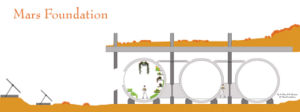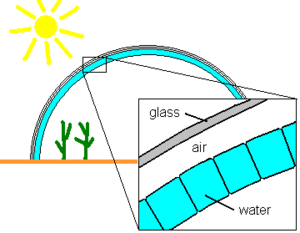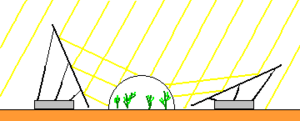Difference between revisions of "Greenhouse"
m (re-jigging image location) |
m (adding image of Eden project +image placement) |
||
| Line 1: | Line 1: | ||
| + | [[image:Eden_project.jpg|thumb|right|300px|[[The Eden Project]]] (near St Austell, Cornwall, UK) is a terrestrial example of the possible use of large ''biomes'' as greenhouses and life support for Mars colonies. ''Image credit: Jürgen Matern]] | ||
Growing plants in a '''Greenhouse''' delivers [[oxygen]] and [[food]]. It can play an important part in human recreation ([[Mars Garden Wins Gold at London’s Chelsea Flower Show (MarsHome.org)|Mars Garden]]). The [[sunlight]] is not bright enough on Mars to allow usual terrestrial plants to thrive, but it provides a valuable part of light energy for plants. | Growing plants in a '''Greenhouse''' delivers [[oxygen]] and [[food]]. It can play an important part in human recreation ([[Mars Garden Wins Gold at London’s Chelsea Flower Show (MarsHome.org)|Mars Garden]]). The [[sunlight]] is not bright enough on Mars to allow usual terrestrial plants to thrive, but it provides a valuable part of light energy for plants. | ||
| Line 9: | Line 10: | ||
==Side-lit Greenhouse Concept== | ==Side-lit Greenhouse Concept== | ||
| − | [[Image:Greenhouse_marsfoundation.jpg|thumb| | + | [[Image:Greenhouse_marsfoundation.jpg|thumb|left|300px|The [[Mars Foundation]] concept for a side-lit greenhouse.]] |
The [[Mars Foundation]] concept for a greenhouse involves the maximum use of local materials to avoid waste, maximize energy input and optimize space. Spawned from the [[Hillside settlement]] design, the greenhouse would most likely be located inside/next to a hill side (possibly in the location of [[Candor Chasma]]). Therefore [[regolith]] or some other absorbant material could be suspended above the greenhouse to protect occupants and plants from [[solar radiation|harmful radiation]]. The source of light would therefore be directed from the side, via an array of adjustable mirrors. A system of vents and ducts would allow warm air to circulate, perhaps even used to heat the main habitat. | The [[Mars Foundation]] concept for a greenhouse involves the maximum use of local materials to avoid waste, maximize energy input and optimize space. Spawned from the [[Hillside settlement]] design, the greenhouse would most likely be located inside/next to a hill side (possibly in the location of [[Candor Chasma]]). Therefore [[regolith]] or some other absorbant material could be suspended above the greenhouse to protect occupants and plants from [[solar radiation|harmful radiation]]. The source of light would therefore be directed from the side, via an array of adjustable mirrors. A system of vents and ducts would allow warm air to circulate, perhaps even used to heat the main habitat. | ||
==Water-shield Greenhouse Concept== | ==Water-shield Greenhouse Concept== | ||
| − | [[Image:WaterShieldGreenhouse.png|thumb| | + | [[Image:WaterShieldGreenhouse.png|thumb|right|300px|Water-shield Greenhouse Concept]] |
[[Hydrogen]] does a good job absorbing [[cosmic radiation]]. [[Water]] contains highly concentrated hydrogen, and hence serves as a good radiation shield. On the other hand it is highly transparent for visible light and UV. The combination of both makes it an interesting material for greenhouse shielding. | [[Hydrogen]] does a good job absorbing [[cosmic radiation]]. [[Water]] contains highly concentrated hydrogen, and hence serves as a good radiation shield. On the other hand it is highly transparent for visible light and UV. The combination of both makes it an interesting material for greenhouse shielding. | ||
| Line 22: | Line 23: | ||
==Multiplying Sunlight== | ==Multiplying Sunlight== | ||
| − | [[Image:MultipleMirrorsForGreenhouse.png|thumb| | + | [[Image:MultipleMirrorsForGreenhouse.png|thumb|left|300px|Multiple Mirrors for Greenhouse]] |
A set of mirrors can be used to bring more sunlight into the greenhouse than the base area of the greenhouse receives directly from the sun. Three times the amount of Martian sunlight should be enough to serve terrestrial plants. During good weather periods this allows growing vegetables without additional energy. | A set of mirrors can be used to bring more sunlight into the greenhouse than the base area of the greenhouse receives directly from the sun. Three times the amount of Martian sunlight should be enough to serve terrestrial plants. During good weather periods this allows growing vegetables without additional energy. | ||
Revision as of 13:48, 17 December 2007

Growing plants in a Greenhouse delivers oxygen and food. It can play an important part in human recreation (Mars Garden). The sunlight is not bright enough on Mars to allow usual terrestrial plants to thrive, but it provides a valuable part of light energy for plants.
The greenhouse will be constructed from transparent material, allowing maximum sunlight to pass, generating an artificial "greenhouse effect". The spectral properties of the material should be optimized to match the absorption characteristics of chlorophyll, maximizing the energy gain.
Plants need a mix of air pressure and temperature. The greenhouse must be strong enough to hold that air pressure, and it must be insulating to hold the temperature inside.
Additional energy is necessary to light and heat the greenhouse.
Contents
Side-lit Greenhouse Concept

The Mars Foundation concept for a greenhouse involves the maximum use of local materials to avoid waste, maximize energy input and optimize space. Spawned from the Hillside settlement design, the greenhouse would most likely be located inside/next to a hill side (possibly in the location of Candor Chasma). Therefore regolith or some other absorbant material could be suspended above the greenhouse to protect occupants and plants from harmful radiation. The source of light would therefore be directed from the side, via an array of adjustable mirrors. A system of vents and ducts would allow warm air to circulate, perhaps even used to heat the main habitat.
Water-shield Greenhouse Concept
Hydrogen does a good job absorbing cosmic radiation. Water contains highly concentrated hydrogen, and hence serves as a good radiation shield. On the other hand it is highly transparent for visible light and UV. The combination of both makes it an interesting material for greenhouse shielding.
Under a strong pressure resistent housing the water is placed in a thick layer. It absorbes the dangerous parts of cosmic radiation and sunlight and passes most of the spectral parts needed by humans and plants. Additionally, it helps to buffer daily temperature variations because of its high specific heat capacity.
The layering could be as follows: The outer layer is a construction of steel and glass, providing enough strength for the difference in atmospheric pressure. It also serves as insulation for temperature differences. Additional sheets of glass or plastics improve the insulation effect. A self-healing puncture protection should be considered. The innermost layer is the water. It can be held by transparent canisters.
Multiplying Sunlight
A set of mirrors can be used to bring more sunlight into the greenhouse than the base area of the greenhouse receives directly from the sun. Three times the amount of Martian sunlight should be enough to serve terrestrial plants. During good weather periods this allows growing vegetables without additional energy.
Flora and fauna
Plants can be grown either in liquid fertilizer (hydroponics) or in soil. Many plants live in symbiosis with microbes and insects. Bees can be used to pollinate the blossoms for fruit plants. Probably, the greenhouse is less labor-intensive with as many natural processes as possible.
Open Issues
- How long can plants survive without sunlight (e.g. during a dust storm)?
- How much greenhouse area is needed per person for food production?
- How many persons are needed to work in the greenhouse to produce enough food for a hundred persons?
- How much additional energy is needed per square meter?
- What temperature and air pressure do plants need?
- What air pressure is needed for persons to work in the greenhouse?
- What transparent materials match the absorption characteristics of chlorophyll?
External links
| Concepts: | Greenhouse · Settlements · Locations · General |
| Hazards: | Space Weather · Climate · General |
| Technology: | Hi-Tech · Lo-Tech · Energy · Spaceflight science · Communication · General |
| Human Considerations: | Economics · Health · Governance · Trade · Law · Social |








